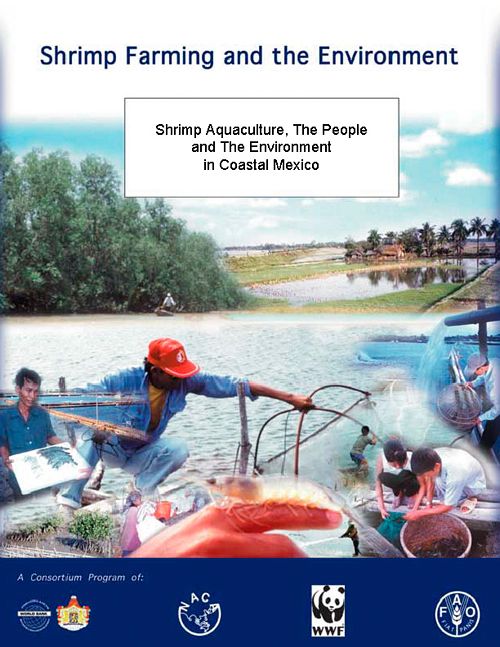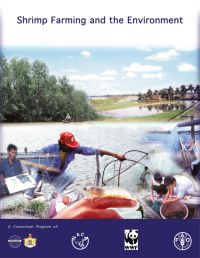Shrimp aquaculture, the people and the environment in coastal Mexico
1 June 2005 | Billie R. DeWal, Jaime Renán Ramírez Zavala, Lorena Noriega and Rosa Esthela González | 1494 Downloads | .pdf | 1021.43 KB | Better management practices, Health and Biosecurity, Livelihoods, gender and social issues, Aquatic plants, Shrimp, Environment and Sustainability, Water quality
The shrimp aquaculture sector in Mexico has experienced a boom in recent years, particularly following the 1992 revisions to Article 27 of the Constitution (Agrarian reform legislation) and to the Fisheries Law. This case study documents the social and environmental effects of aquaculture, the effectiveness of government in regulating the industry, the interactions between new producers and long-term residents of coastal areas and the sources of investment in the industry. Individuals from many different stakeholder groups were consulted to ensure that their concerns and viewpoints are adequately reflected in the analysis. In addition, the report identifies the most important interventions needed to make shrimp aquaculture economically and environmentally sustainable.
Approximately 90% of operating shrimp aquaculture farms are located in the three states of Sonora, Sinaloa, and Nayarít, accounting for 95% of the production of farmed shrimp in the country. Basic facts about recent shrimp farming operations include the following:
- The number of producers nearly doubled in the period between 1993 and 1998, to nearly 400 farms.
- There are now nearly 21,000 ha of shrimp aquaculture ponds in the country.
- Average annual yields are approximately 1.34 MT per hectare.
- Shrimp aquaculture production was valued at approximately US$ 28 million in 1998.
- Shrimp farming has generated approximately 8,000 direct jobs (and perhaps twice as many indirect and part-time jobs) in regions of the country that offer few other economic options.
- Aquaculture now contributes approximately 25% of total shrimp production in Mexico, about the same as near-shore fisheries, but still lagging the high-seas fishery, which provides about 50%.
- Of Mexico’s total production of 71,609 MT of shrimp in 1998, it exported about 53% of the total (38,221 MT), with 98% of exports going to the United States. There is an excellent domestic market for shrimp in Mexico, as well, and competition for product keeps prices to producers relatively high.
The historical legacy of agrarian reform has resulted in about 80% of the shrimp aquaculture farms still being held by the cooperative/ejido sector; these producers still account for about 48% of the farm-raised shrimp in the country. When individuals from ejidos decide to sell or lease their lands, they receive good prices. “Participation Associations” are being formed in some areas. In these situations, the private sector develops an aquaculture park in which a portion remains in the hands of the cooperative/ejido sector that has traditionally held the property rights to the land.
In Mexico, the issue of coastal property rights is quite complicated: federal zones, subdivided ejido lands, communal ejido lands, private property and areas in which cooperatives have been granted fishing rights can overlap or exist in close proximity. Disputes over boundary lines and associated property rights among these stakeholders are common.
All producers in both the cooperative/ejido and private sector are quite concerned about losses from disease. Mexico’s use of hatchery postlarvae is extensive, with about 90% of production now using this source. This may help in preventing further disease outbreaks.
Approximately 23% of shrimp farms in Mexico were not producing in 1998, primarily because of shrimp disease, poor site choice for the farm, or lack of capital.
Shrimp aquaculture in Mexico has thus far developed largely without the major detrimental environmental effects seen in other countries of the world. Little evidence of mangrove destruction has been discovered. The most serious threat from shrimp aquaculture is probably its potential effects on water quality.
Capital to invest in shrimp farming comes from a diverse range of sources. Private capital, national banks and financial institutions have provided most of the money invested. Input suppliers (For feed and postlarvae) and marketers are also providing extended credit and/or loans to farmers. Some foreign investment is present, but most of the capital being invested originates in Mexico.
Substantial progress has been made within SEMARNAP (Ministry of the Environment, Natural Resources, and Fisheries), the main regulatory, monitoring and enforcement agency. A reasonable structure of legal regulations and standards now exists. Enforcement is still a problem, with PROFEPA (The Attorney General for Environmental Protection) suffering from a lack of funding, but the situation appears to be improving.
Overall, the state of aquaculture in Mexico appears to be evolving in a very positive direction. Because of the results stemming from its Revolution, Mexico may be the only place in Latin America in which the resource-poor sector will play a big role in production of farmed shrimp. Regulation and monitoring of the industry are still in their infancy, but SEMARNAP is putting in place a system that may be able to ensure that aquaculture will be sustainable. The presence of a strong system of universities and applied research institutes should help with the development and monitoring of the industry. More effective involvement of the NGO community in the aquaculture sector may also help to monitor and ensure compliance with environmental regulations.
The major threat to developing a sustainable shrimp farming industry in Mexico is shrimp diseases. Disastrous declines in production because of disease spread, and resulting uncertainty, may make many producers unwilling to invest in the technology needed to make their operations more socially and environmentally sustainable.
Copyright, all rights reserved.

